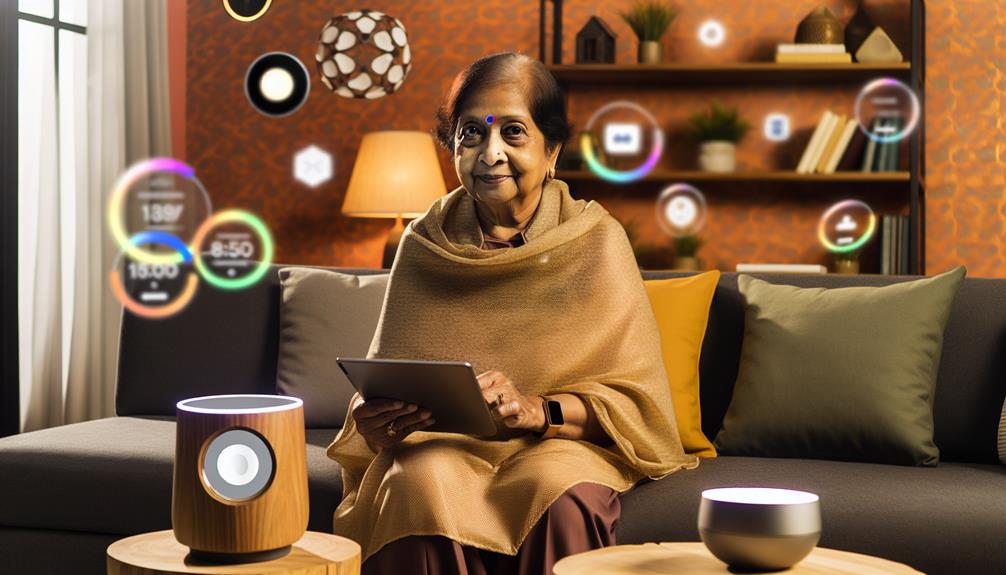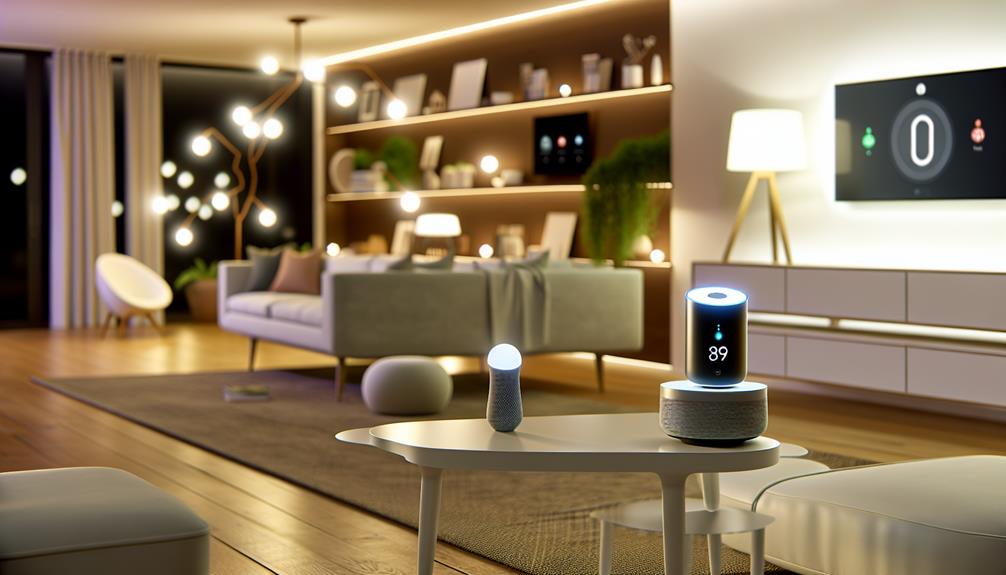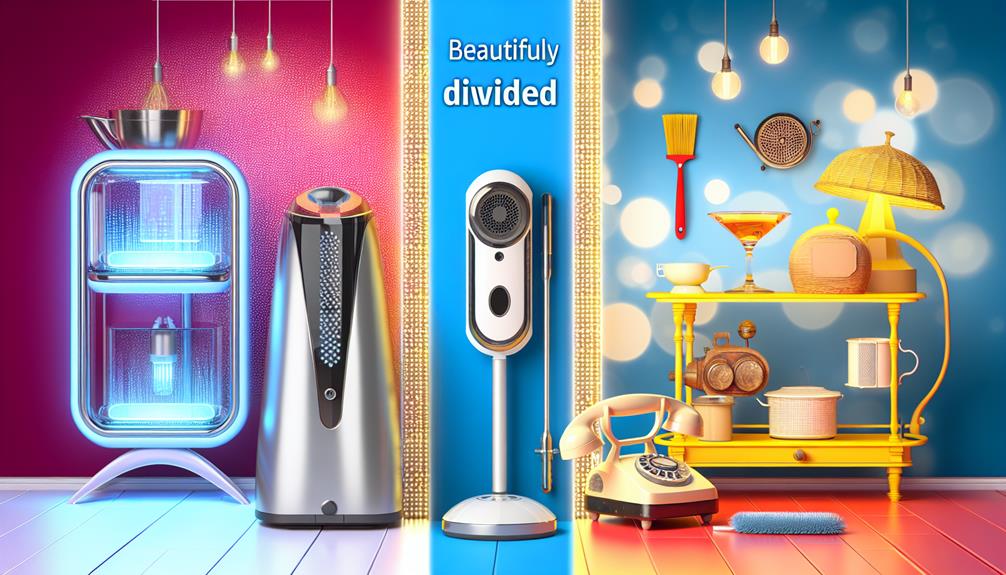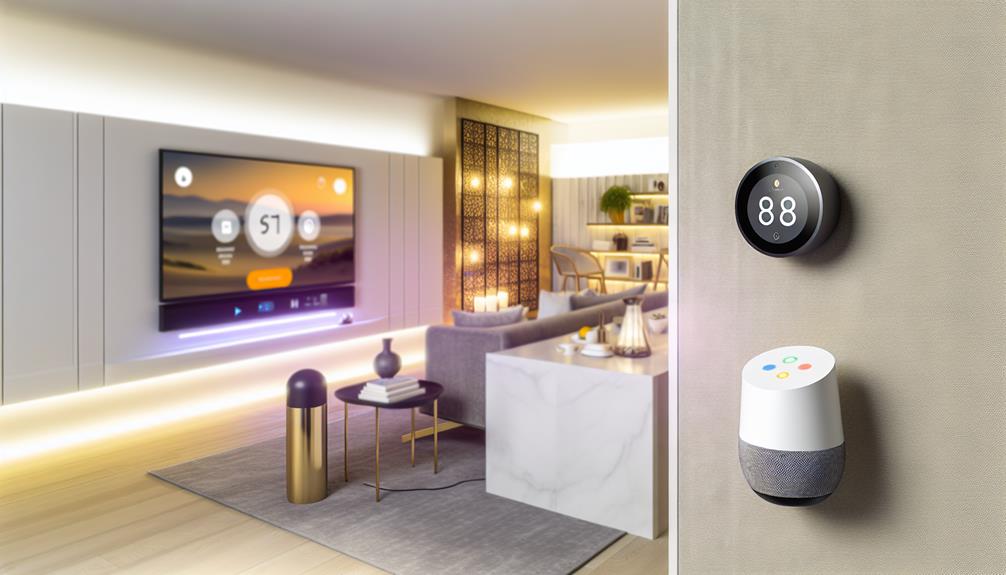Trusted Smart Gadgets for Elderly Care
As the population of elderly individuals continues to grow, the integration of trusted smart gadgets into their care has become increasingly significant. These technologies not only enhance safety and independence but also foster a supportive environment that prioritizes their dignity. From AI-driven health monitors to smart security systems, the array of available devices offers solutions tailored to the unique challenges faced by seniors. However, the effectiveness of these technologies hinges on various factors, prompting a deeper examination of their implementation and impact on the lives of elderly individuals. What considerations must be addressed to guarantee ideal outcomes?
Key takeaways
- Smart home devices enhance comfort by automating lighting and temperature control, promoting safety and independence for elderly individuals.
- AI-driven health monitoring offers real-time insights and alerts caregivers to potential health issues, fostering a supportive environment.
- Voice-activated assistants provide hands-free interaction, reducing loneliness and empowering seniors to manage their daily activities effortlessly.
- Smart security systems, including surveillance and motion detectors, enhance safety and enable remote monitoring for prompt intervention during emergencies.
- Fall detection technologies integrate wearable sensors and mobile apps to ensure immediate alerts and assistance, significantly improving safety for elderly users.
Benefits of Smart Home Devices
In many households, the integration of smart home devices has emerged as a pivotal advancement in enhancing the quality of life for the elderly. Among these devices, smart temperature control and automated lighting systems stand out for their ability to foster comfort and safety.
Smart temperature control enables seniors to maintain their preferred indoor climate effortlessly, reducing the risk of heat-related illnesses or cold exposure. By allowing users to adjust settings via a smartphone app or voice command, these systems promote independence while ensuring a cozy environment.
This tailored comfort not only enhances physical well-being but also contributes to emotional stability, as individuals can feel more at home in their surroundings.
Automated lighting systems further support elderly individuals by providing illumination that adapts to their needs. For instance, motion-sensor lights can illuminate hallways or bathrooms automatically, reducing the risk of falls during nighttime visits.
Additionally, programmable lighting can create a welcoming atmosphere, fostering a sense of security and belonging.
Taken together, these smart home devices represent a significant step toward empowering the elderly, allowing them to enjoy greater independence while ensuring their safety and comfort within their living spaces.
AI-Driven Health Monitoring
Smart home devices not only enhance comfort and safety but also play a crucial role in monitoring the health of elderly individuals. AI-driven health monitoring systems leverage advanced technology to provide real-time insights into essential health metrics, fostering a sense of security among caregivers and family members.
Wearable devices, such as smartwatches and fitness trackers, are key components of this innovative landscape. These devices enable remote health monitoring, allowing users to track heart rates, sleep patterns, and physical activity levels effortlessly. The data collected is often analyzed using AI algorithms, which can detect anomalies and alert caregivers in case of potential health issues.
Moreover, the integration of AI allows for personalized health assessments, enabling elderly individuals to receive tailored recommendations based on their unique health profiles. This approach not only promotes proactive health management but also empowers seniors to take an active role in their well-being.
Ultimately, AI-driven health monitoring enhances the connection between elderly individuals and their caregivers, fostering a supportive environment that prioritizes health and safety while fostering a sense of belonging in the community.
Voice-Activated Assistants
Voice-activated assistants represent a significant advancement in technology that enhances communication and daily living for the elderly.
These devices offer hands-free interaction, allowing users to make calls, send messages, and access information without needing to physically engage with a device.
Additionally, their daily assistance features—such as reminders for medication, scheduling appointments, and controlling smart home devices—significantly improve the quality of life for seniors by promoting independence and ease of use.
Hands-Free Communication Benefits
Harnessing the power of voice-activated assistants can greatly enhance communication for the elderly, allowing them to interact seamlessly with their environment. These smart devices facilitate hands-free communication, enabling seniors to connect with family and friends without the need for physical dexterity. This accessibility fosters a sense of belonging, as individuals can easily reach out to loved ones, share experiences, and maintain relationships.
Moreover, voice-activated assistants provide virtual companionship, reducing feelings of loneliness that can often accompany aging. By allowing elders to engage in conversations, ask questions, or simply share their thoughts, these devices help bridge the gap between isolation and social interaction.
Additionally, they enable remote engagement, permitting family members to check in or participate in activities from afar, further reinforcing social bonds.
The simplicity of voice commands empowers seniors to take control of their communication, making technology an ally rather than a barrier. By prioritizing ease of use and fostering connection, voice-activated assistants can greatly improve the quality of life for the elderly, ensuring they remain engaged and connected in an increasingly digital world.
Daily Assistance Features
Many elderly individuals face challenges in managing daily tasks, and voice-activated assistants can greatly alleviate these burdens.
These smart devices offer a range of features designed to enhance the quality of life for seniors, providing support that promotes independence and well-being.
One notable feature is grocery reminders, which help seniors keep track of their shopping needs without the hassle of physical lists.
By simply asking their assistant to remind them of items needed, they can guarantee they remain stocked with essentials, reducing the risk of running out of crucial supplies.
Additionally, activity tracking is another essential feature that can be beneficial for elderly users.
Voice-activated assistants can log daily activities, encouraging a more active lifestyle while providing family members with updates on their loved ones' movements and routines.
This not only fosters a sense of connection but also offers caregivers peace of mind.
Smart Security Systems
Smart security systems have emerged as essential tools for enhancing the safety and well-being of elderly individuals living alone or in assisted environments. These systems utilize smart surveillance technologies, enabling caregivers and family members to maintain a vigilant watch over their loved ones from afar. With features such as high-definition cameras and motion detectors, these solutions provide peace of mind, allowing users to monitor their surroundings in real-time.
Remote monitoring capabilities are particularly beneficial for elderly individuals who may be at risk of wandering or experiencing emergencies. By integrating smart security systems with mobile applications, caregivers can receive instant alerts about unusual activities or potential hazards in the home, facilitating prompt intervention when necessary. This proactive approach not only enhances safety but also fosters a sense of independence among the elderly.
Moreover, many smart security systems offer two-way communication, allowing seniors to easily reach out for assistance if needed. This feature promotes a sense of connection, assuring elderly individuals that they are not alone.
Fall Detection Technology
Fall detection technology encompasses various types of sensors designed to monitor and respond to falls among the elderly.
These systems provide significant benefits, such as immediate alerts to caregivers and emergency services, ensuring timely assistance.
In addition, the integration of fall detection devices with smart home systems enhances their effectiveness, creating an all-encompassing safety network within the living environment.
Types of Fall Sensors
In the domain of elderly care, various types of fall sensors have emerged as vital tools for enhancing safety and promoting independence. These technologies provide peace of mind for both seniors and their caregivers by guaranteeing swift responses to potential falls.
The prominent types of fall sensors include:
- Wearable Sensors: These discreet devices can be worn as bracelets or pendants, equipped with accelerometers to detect sudden movements that indicate a fall.
- Pressure Sensors and Floor Mats: Strategically placed under carpets or mats, these sensors detect weight changes, prompting alerts if a fall occurs.
- Integrated Systems with Mobile Applications: These systems combine real-time tracking with user-friendly interfaces, allowing caregivers to monitor their loved ones' safety remotely through notification systems and smart alarms.
The versatility of these fall detection technologies, ranging from environmental monitoring to wearable sensors, is vital in fostering a safe living environment.
Benefits of Alerts
Alerts generated by fall detection technology play a pivotal role in enhancing the safety and well-being of elderly individuals. These alerts facilitate timely intervention, greatly reducing the risks associated with falls—one of the leading causes of injury among seniors. By employing proactive notifications, these systems can swiftly notify caregivers or emergency services, ensuring that help is on the way without delay.
Moreover, personalized alerts can be tailored to meet the specific needs and preferences of the elderly individual. This customizability fosters a sense of autonomy and dignity, allowing seniors to feel more empowered in their living environment. For instance, some systems can distinguish between minor mishaps and severe falls, ensuring that only the most critical situations trigger a response.
This precision not only alleviates unnecessary worry for both seniors and their loved ones but also builds a supportive network around the individual, reinforcing their sense of belonging.
Ultimately, the benefits of alerts in fall detection technology extend beyond mere safety; they cultivate an environment where elderly individuals can thrive, knowing that help is readily available should they need it.
Integration With Smart Home
Leveraging the capabilities of smart home technology, fall detection systems can be seamlessly integrated into an elderly individual's living environment, enhancing both safety and convenience. This integration guarantees that seniors can live independently while benefiting from a supportive network of smart devices that respond to their needs.
- Smart Lighting: Automated lighting can be programmed to illuminate pathways during the night, reducing the risk of falls. When a fall is detected, smart lights can flash or turn on, alerting nearby caregivers or family members.
- Temperature Control: Maintaining a comfortable living environment is vital for the elderly. Fall detection systems can integrate with smart thermostats to adjust temperatures automatically, making certain that seniors are not exposed to extreme conditions, which could lead to accidents.
- Emergency Alerts: In the event of a fall, the system can send alerts to designated contacts or emergency services, guaranteeing prompt assistance is available.
Incorporating these technologies not only increases safety but also fosters a sense of belonging and independence for elderly individuals. This allows them to thrive within their homes while staying connected to their support network.
Medication Management Solutions
Effective medication management solutions are crucial for ensuring that elderly individuals adhere to their prescribed treatment regimens. With the complexities of multiple medications, integrating technology into daily routines can greatly enhance adherence. Pill organizers equipped with smart features allow users to sort medications by day and time, reducing the risk of missed doses.
Medication reminders via health apps can send alerts directly to smartphones or smartwatches, prompting users when it's time to take their medications. Additionally, dosage tracking features enable caregivers and family members to monitor adherence patterns, fostering a supportive environment.
Refill alerts help prevent interruptions in therapy by notifying users when it's time to restock medications, ensuring a seamless supply. Pharmacy integration is another crucial aspect, allowing users to manage prescriptions and refills in one centralized platform, often linked to their health apps.
These adherence solutions can be customized to create personalized schedules, accommodating individual needs and preferences. By leveraging these tools, families can enhance the quality of care for elderly loved ones, promoting independence while ensuring health and safety are prioritized.
Embracing these innovations fosters a sense of belonging and support within the community.
Home Automation for Comfort
Home automation technology has emerged as a significant enhancement to the daily lives of elderly individuals, complementing the medication management solutions that support their health.
By integrating smart devices into their homes, seniors can enjoy a greater sense of comfort and independence.
Key features of home automation for elderly care include:
- Automated Lighting: Smart lighting systems can be programmed to turn on or off at specific times, reducing the risk of falls during nighttime hours and allowing seniors to navigate their homes safely.
- Temperature Control: Automated thermostats enable elderly individuals to maintain a comfortable living environment effortlessly. These systems can learn preferences and adjust temperatures accordingly, guaranteeing ideal comfort without manual intervention.
- Voice-Activated Assistance: Voice-activated devices offer convenience, allowing seniors to control various functions in their homes without needing to physically interact with switches or remotes.
Incorporating these home automation features fosters a sense of security and belonging, helping elderly individuals maintain their dignity and autonomy.
Emergency Response Systems
While the integration of smart technology into senior care has transformed daily living, an essential component remains the implementation of emergency response systems. These systems are critical for ensuring safety and peace of mind for both seniors and their families. They typically include wearable devices or home-based units that can quickly connect users to emergency services, allowing for immediate assistance in times of need.
Effective emergency preparedness is paramount, and response training plays a crucial role in this process. Seniors should be familiarized with how to use their emergency response systems, enabling them to act swiftly in emergencies. Training can encompass everything from understanding the device's features to practicing scenarios that may arise, fostering confidence and independence.
Furthermore, integrating these systems into daily routines can create a sense of security, encouraging seniors to engage more fully in their lives. Family members can also benefit from knowing that their loved ones are equipped with reliable emergency support, fostering a supportive community around them.
Ultimately, emergency response systems are an indispensable tool in senior care, reinforcing safety and enhancing the quality of life for the elderly.
Social Connection Tools
Social connection tools have emerged as essential resources in enhancing the well-being of the elderly, addressing the significant issue of social isolation that many seniors face.
These tools leverage technology to foster relationships and provide a sense of belonging, which is vital for mental and emotional health.
Here are three effective social connection tools:
1. Social Media Platforms: Websites like Facebook and Instagram allow seniors to connect with family and friends, share experiences, and stay updated on loved ones' lives.
These platforms can bridge geographical gaps and reduce feelings of loneliness.
2. Video Calling Apps: Tools such as Zoom and Skype facilitate virtual gatherings, enabling seniors to participate in family events, book clubs, or just casual chats.
These interactions can replicate the warmth of in-person meetings, strengthening emotional ties.
3. Online Community Forums: Websites dedicated to hobbies, interests, or peer support groups provide a space for seniors to engage with others who share similar passions.
This can foster new friendships and enhance social interaction.
Frequently Asked Questions
How Much Do Trusted Smart Gadgets for Elderly Care Typically Cost?
The cost of trusted smart gadgets can resemble a varied garden, with prices ranging from budget considerations of $50 to $300. Device longevity often justifies the investment, ensuring reliable support for years to come.
Are These Devices Easy to Install Without Professional Help?
Many of these devices feature user-friendly installations and self-guided setup processes, enabling individuals to install them independently. This accessibility promotes confidence and independence, ensuring users feel empowered while integrating technology into their daily lives.
What Happens if the Internet Goes Down?
When the internet goes down, it can feel like the world has come to a standstill. Ensuring internet reliability through backup solutions, such as mobile hotspots, is essential to maintain functionality and support seamless connectivity.
Can Smart Gadgets Integrate With Existing Home Systems?
Smart gadgets can indeed integrate with existing home systems, ensuring smart home compatibility and device interoperability. This connectivity enhances user experience, allowing seamless control and monitoring, thereby fostering a sense of belonging and security within the home environment.
Are There Privacy Concerns With Using These Devices?
Privacy concerns with smart devices primarily revolve around data security and user consent. Ensuring robust encryption and transparent data usage policies can mitigate risks, fostering trust and a sense of belonging among users in an interconnected environment.



